Why Americans will continue to misunderstand Hinduism
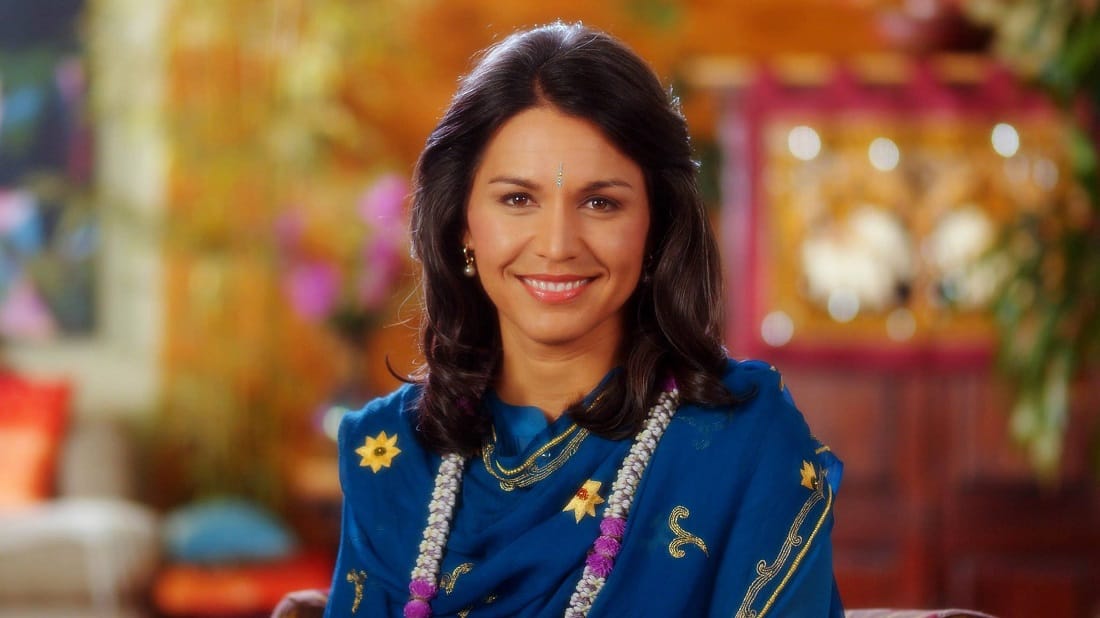
Tulsi Gabbard’s nomination by Donald Trump for DNI (Director of National Intelligence) has angered a predictable but unlikely group of commentators. For the neoliberals opposed to Donald Trump, she’s an agent of Russia, China, Syria, or a combination of all three. Ethno-nationalists oppose her for her skin color, and her religious background: Tulsi is a proud Hindu of Polynesian heritage. For once American progressives have common ground with the white supremacists in their opposition to a Hindu-American politician. They point to her friendship with India’s Prime Minister Narendra Modi, whose brand of right-wing Hindu Nationalism is a focal point for left-wing activism around the world. Add India as another country she’s an agent of. This opposition reveals a deeper issue: a limited American understanding of Hinduism shaped by an outdated framework that struggles with modern Hinduism and its 1.2 billion adherents.
Culturally, most Americans think in binaries—good versus evil, freedom versus tyranny, democracy versus monarchy— a view largely influenced by Protestant Christianity and its history. This binary framework permeates American politics and culture, whether it’s the right-wing’s focus on tradition versus progress or the left-wing’s emphasis on inequality versus equality. The OS (Operating System) of Indian culture is Hinduism, which doesn't fit neatly into these binaries. Broadly speaking, Hindu philosophy believes that all of creation is divine, integrating both the light and the dark. There's no strict separation between good and evil; instead, there's a focus on personal enlightenment over proclamations of faith. It’s unfamiliar to American culture— where publicly testifying to one’s beliefs and values is the norm. Hinduism’s mythologies are diverse: if the Ramayana tells a story of good triumphing over evil, the Mahabharata is about a civil war where neither side has perfect heroes or villains. Over the years, Hinduism has branched off into many religious traditions and reform movements, some of which are monotheistic, or atheist, while still retaining the OS of Hinduism.
Simply put, Americans don’t understand or respect cultures where moral certainty, and rigid binaries don’t exist. The fluidity and moral complexity of Indian culture is often misunderstood by American thinkers. Even during a historical decline in religious belief among the elite— much of the American intellectual and political class remains influenced by the protestant framework, and it shapes their attitudes towards other religious groups. American intellectuals often express suspicion of religious groups that diverge from WASP culture. Liberal anxiety over Catholic success in the legal profession is one such example.
Today’s Democratic elite signal their status by openly expressing their dislike of the Catholic members of the Supreme Court. Hating Amy Coney Barrett or Brett Kavanaugh is a key requirement for ideological alignment within left-wing politics. Or take the treatment of catholic groups like Opus Dei, frequently depicted as a secretive mafia-like group, a comical league of supervillains. Such portrayals reflect deep-rooted Protestant anxiety about catholicism, and catholic immigration. Decades ago these anxieties were expressed through prejudiced notions about dual loyalties - fear mongering that catholics would obey the pope over the American constitution. The persistence of these anxieties today, despite America having had two catholic presidents shows how protestant morality still shapes the attitude of the secular elite toward public religiosity, especially from non-WASP immigrant groups.
The Hindoo in the American Imagination
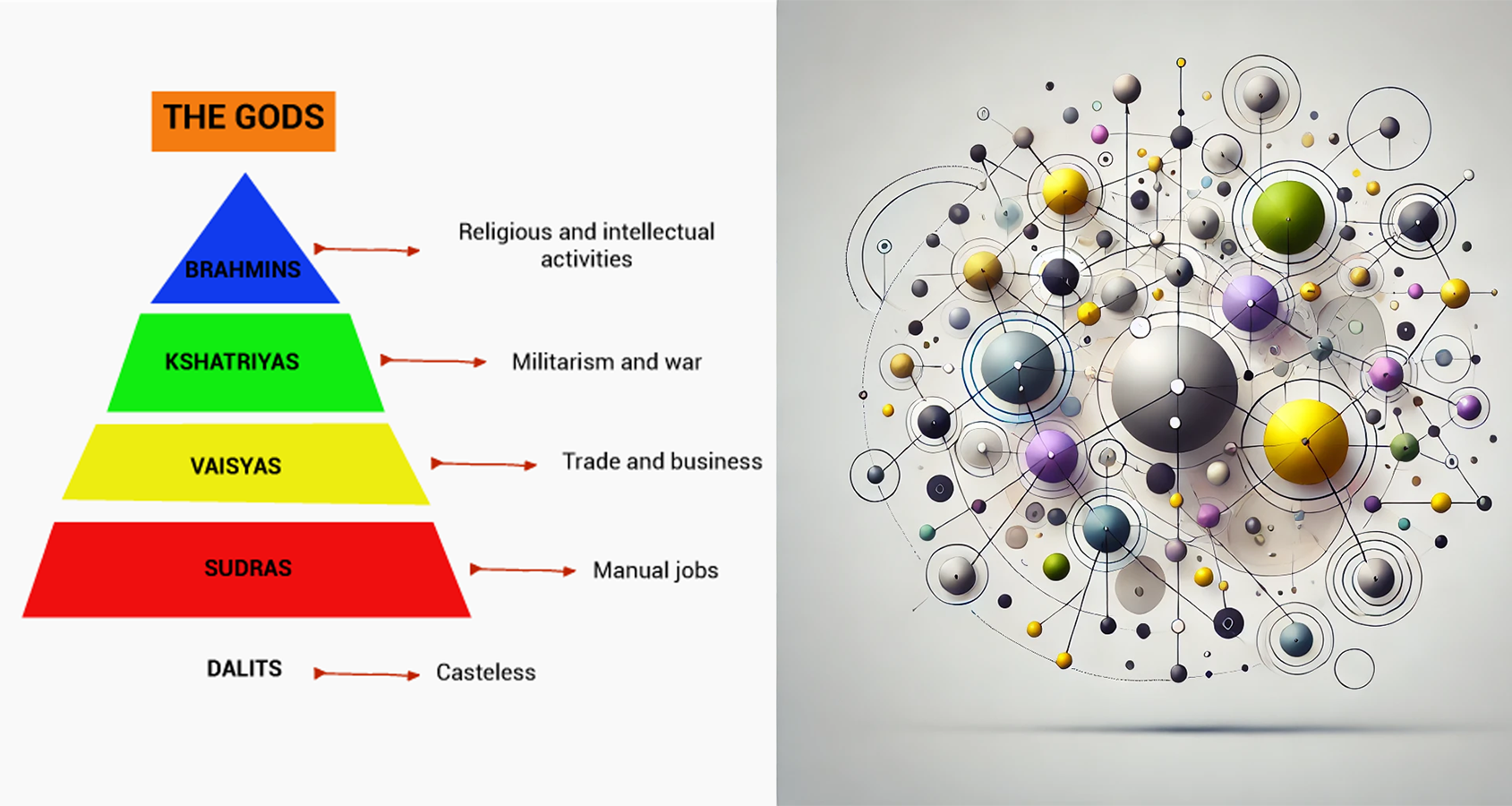
This framework also informs much of the discourse around the Indian Hindu Diaspora, especially in the obsession over the caste system. The Indian caste system is horizontal, with complex social dynamics, and networks of interdependent relationships. Americans have oversimplified its complexity to a pyramid of oppressors and the oppressed. This view was formed in the early days of American culture where protestant culture was seen as the most civilized and egalitarian, and other cultures were treated as half-civilized. Historian Michael Altman documents early children’s school books like The Tales of Peter Parley that described ‘Hindoos’ sacrificing women and children to ‘gain favor with their gods.’ “Caste stood out as a central theme in descriptions of India.” Caste fit into the overall understanding of India as a half-civilized land. “Children were taught…Hindoo religion led to a hierarchical caste system, while Protestant Christianity brought egalitarian democracy.” These stories created a sense of superiority and national pride in American children. Professor of American Religion Kathryn Gin Lum: “The idea of the heathen world in need was especially helpful for a young nation that was figuring out its global status, where European-descended settlers could not claim the land as the original birthright of their ancestors”
Altman also highlights how Harper’s Magazine, the first nationally read periodical, reinforced these stereotypes about Indian society. Its founder touted Harper’s as a ‘popular educator of the general public’ - the magazine promoted the superiority of ‘whiteness, protestantism, and American democracy.’ Much like the children’s books, ‘Representations of Hindoo religion appeared on the pages of Harper’s to entertain and educate readers as they reinforced the superiority and importance of white protestant America.’ It was from Harper’s where the protestant hatred of Catholics and ‘Hindoos’ came together to create the famous cartoon of Catholic bishops as crocodiles emerging from the Ganges River to threaten Protestant American children. The cartoon's imagery was a potent symbol of early American beliefs, linking Catholicism and Hinduism under a common narrative of foreign religious danger.
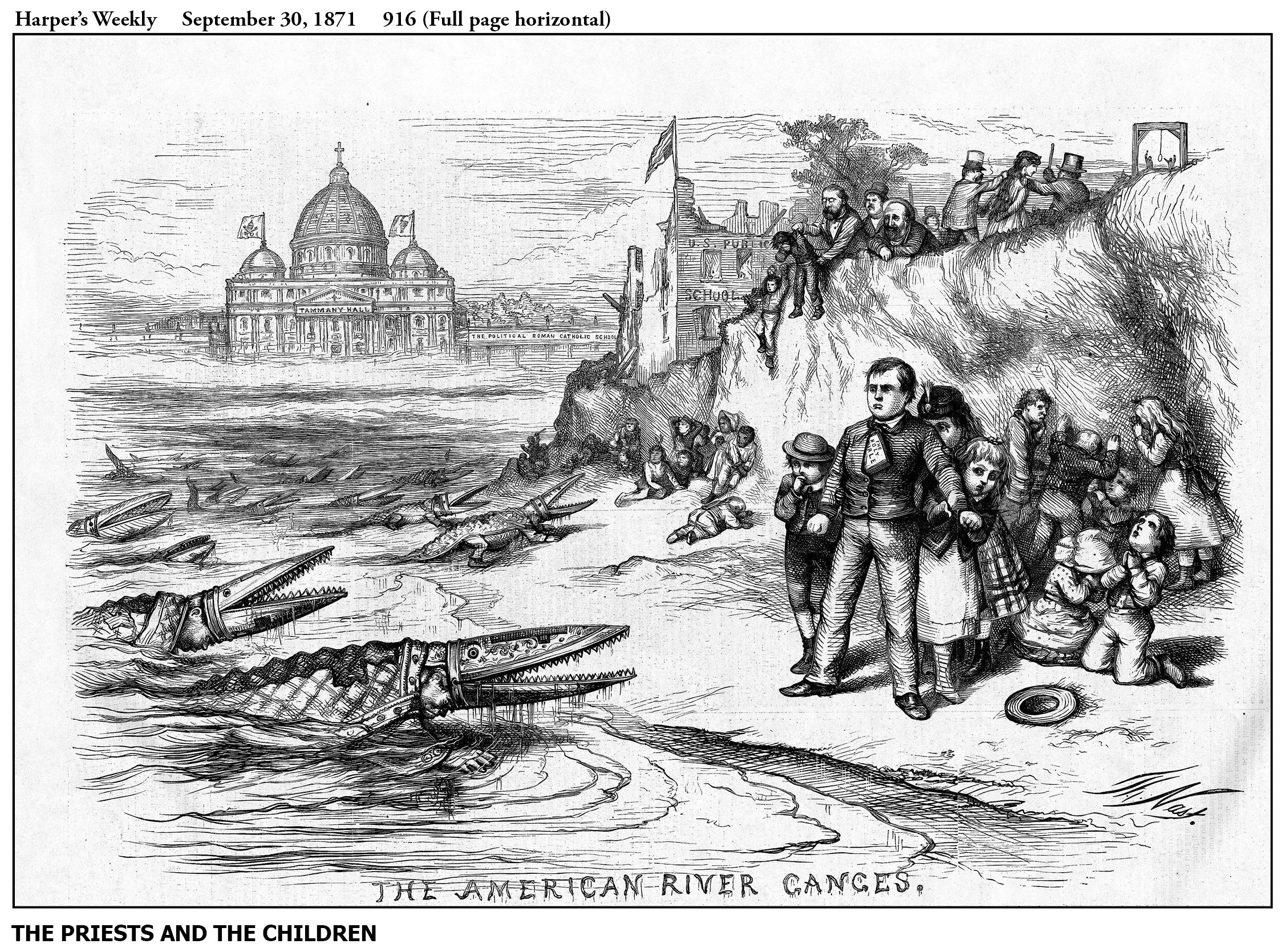
More than a hundred years later, Harper’s editorial perspective on Hindus hasn’t changed much. A recent article from Harper’s Magazine called “The Hindutva Lobby” reflects the same century old anxiety about the rise of a new successful immigrant group with no loyalties to the old order. My friend Vishal Ganesan had the best response to the article:
“grounded in a primordial and deep fear of Indians “contaminating” American political and cultural life.”
Elite Anxiety about Immigrants
Professor Amy Wax is a tenured law professor at the University of Pennsylvania who gained notoriety for incendiary comments she made about minorities, including Indian immigrants— comments for which she was recently suspended by UPenn. Dr. Wax has defended her comments as heterodox beliefs that challenge the egalitarian ideology of academia and left wing intellectuals. Wax’s defenders on the right use three arguments to come to her defense: she’s defending western civilization, she’s entitled to free speech as a tenured academic, and her comments about non-whites, and non-white cultures is actually true— debate her on the merits or you lose the right to question her.

“Maybe it’s just that Democrats love open borders, and Asians want more Asians here. Perhaps they are just mesmerized by the feel-good cult of diversity…but as long as most Asians support Democrats and help to advance their positions, I think the United States is better off with fewer Asians and less Asian immigration.”
Amy Wax to Tucker Carlson, April 8, 2022
This argument presupposes that Asian immigrants (Chinese, East Asian, Indian, Pakistani etc.) all vote as a single bloc, and that their relationship to American culture is purely transactional. American immigration laws are highly selective, with a preference for high-skilled, highly-educated immigrants. Wax is focused on a demographic that is more attuned to neoliberalism, lives in urban centers, and seeks to assimilate by taking on the political affiliation of high-status people in their environment - which leans center left. She’s free to make such reductive arguments, oblivious to the emerging trends of Asian-Americans becoming more aligned with the Republican party. The California GOP has wide support from Asian-Americans and includes two Congresswomen of Korean descent. After the 2024 election in which ethnic minorities voted in record numbers for Republicans, Wax’s views seem outdated, resentful broadsides at an outgroup she has a personal grudge against— hardly the nuanced analysis one might expect from a law professor.
“Here’s the problem. They [Indian immigrants] are taught that they are better than everybody else because they are Brahmin elites and yet, on some level, their country is a shit hole…They’ve realized that [the West has] outgunned and outclassed them in every way… They feel anger. They feel envy. They feel shame. It creates ingratitude of the most monstrous kind.”
Amy Wax to Tucker Carlson, April 8, 2022
As demonstrated above, the American tendency to reduce India's complex societal relationships to a simplistic pyramid of oppressors and the oppressed is encapsulated in Wax's statement.
Kathryn Gin Lum: “By equating American elites with Indian Brahmins, Americans projected their own class anxieties onto a foreign social system, reinforcing notions of superiority and hierarchy.”
Wax’s comments are emblematic of the older, paternalistic view of India and Indian immigrants as perpetual outsiders in the West. For views such as hers, the only acceptable Indians in America should be Christian converts. One wonders what she makes of MAGA Indians like Vivek Ramaswamy or Kash Patel and whether their political loyalties challenge any of her assumptions about immigrants.
Michael J Altman: “The idealized image of the convert served to reinforce the perceived superiority of Western civilization and the necessity of its expansion.”
Kathryn Gin Lum: “The transformation of the 'heathen' into a Christian was depicted as a journey from darkness to light, reinforcing binary oppositions between savagery and civilization.”
Wax’s critique, couched in the language of cultural superiority and ressentiment, not only fails to account for the agency of Asian immigrants but also exposes her own insecurities about shifting demographics. Her one-dimensional views reveal less about the immigrant experience and more about the anxieties of an elite clinging to centuries long assumptions about social hierarchy and American identity. Western civilization is in a sad state if it needs defenders like Amy Wax.
To be fair to Evangelical Christianity, one must also credit it for its positive influence on American history: it was responsible for abolitionist movement in England and America that opposed chattel slavery. Its also partly the reason for the American Revolution, due to fear that the Quebec Act would result in absolutism and catholicism invading the American colonies.
Personally, I have no grievance with America. Life in America has been a positive experience for me. I’ve had the honor to serve and defend the constitution and to be a witness to American history firsthand. While I’m critical of Indian-Americans who use their identity to gain leverage in American political discourse, as hypocritical and opportunistic, I take pride in the success of anyone of Indian heritage.
Diaspora Politics and Disunity
Unlike other ethnic groups that define themselves by language, religion, or race, the Hindu diaspora is much more diverse and disunited. While the Indian community in America is incredibly successful, it is not a well-organized group that defends itself from political attacks. We’re an open target for those who fear being displaced by newcomers, and there are no consequences to slandering Indians. Ironically, some of those leading these attacks are part of the South Asian diaspora. Many diaspora organizations are engaged in a competition for recognition, influence, and status in America, the UK, and Canada. Since this competition involves political mobilization of their identity group, importing old grievances from the Indian subcontinent allows them to better assert their identity and provide a sense of continuity. The binary constructs inherent in American society exacerbate this competition into a fight over who speaks for the entire diaspora. Framing diaspora Hindus as an ideological threat to American values is effective because it taps into existing anxieties about multiculturalism, similar to the post-9/11 panic over Sharia law. Another common tactic involves accusing Hindus of dual loyalties, tying them to the policies of India’s current Prime minister Narendra Modi, who is a proud Hindu Nationalist.

Selective criticism from diaspora organizations is a double standard - Hindu communities are scrutinized for their political and cultural affiliations, while issues of crime and transnational terrorism within other communities are downplayed. These organizations use left-liberal talking points, invoking concerns about racism, hate speech, and Islamophobia to shut down any criticism of their own communities. Their persistent demands to scrutinize Hindu organizations in America by law enforcement conveniently overlooks the significant funding received by other diaspora groups and the fact that their lobbying efforts in America are far more effective and influential than those of Hindu American organizations.
In 2024, a surge of op-eds from left-leaning publications, including Harper's, voiced alarm over the growing influence of Hindu-Americans in Washington, D.C. These pieces portray Hindu participation in American politics as insidious, relying on the gullibility of their readers about American political culture. If Indian-origin Congresspeople refuse to join Ilhan Omar's resolution on Kashmir, or Indian diaspora organizations condemn her resolution, it's proof enough that their strings are being pulled from India. Lobbying for interest groups is a standard part of American politics. Just as organizations like CAIR advocate on behalf of Muslim-Americans and influence lawmakers, Hindu-American groups lobbying Indian-origin Congress members is no different. Yet, when Hindus engage in this process, it is spun as suspect or un-American—a glaring double standard designed to marginalize their political participation.
Hindus find themselves at a particular disadvantage in this struggle due to both economic and ideological factors. Muslim and Sikh diaspora communities tend to be more tightly organized around religious institutions with stronger economic foundations. The monotheistic and communal unity seen in Muslim and Sikh groups provides them with a stronger sense of collective identity, particularly when united under concepts such as the ummah (Muslim global community) or qaum (Sikh nation).
Hindu communities, rooted in polytheism and a more pluralistic worldview, do not always rally around a single unifying ideological structure. Hinduism's emphasis on adaptability and integration often leads to a lack of communal unity, which weakens political mobilization efforts. While assimilation can provide economic and social mobility, it places Hindus at a disadvantage in identity-based political struggles. They simply lack the cohesion that other groups cultivate. All of this has resulted in Hindus being less effective in asserting their community’s interests in the political world. The historical stigma attached to polytheism places Hindus in a weaker position as they compete for status in societies that value cohesive religious identities.
Progressive Politics and Indian identity
The left, in particular, struggles with where to fit Hindus in its moral framework. On one hand, they look like minorities; but their collective success challenges the left-wing axioms of race and oppression - the notion that only white people can be successful in America. Consequently, Indian immigrants are often simplistically divided into "high caste" and "low caste" groups, with high caste individuals being "white-coded" and the lower caste subsumed into the broader BIPOC coalition. This allows the American left to treat the Indian community as a monolith between the ‘good’ Indians and the ‘bad’ indians.
Left wing academics contributed to the creation of broad, homogenizing terms like "South Asian," which lump together Indians, Pakistanis, Bangladeshis, and other groups, erasing the rich diversity within our communities. No Indian would agree that Diwali is a ‘South Asian’ holiday, and while communities across Asia celebrate Diwali, the holiday is uniquely tied into Indian geography and history. Calling it “South Asian’ demeans its origins and its significance.

American writer Rob Henderson is famous for coining the term luxury beliefs. He defines luxury beliefs as a belief that confers status upon the believer but imposes costs upon others. The propagation of negative stereotypes about Hindus by elite Indian-Americans is a form of luxury belief. By equating Hinduism with white supremacy or extremist beliefs, condemning Hindu festivals and beliefs as exclusionary, they align themselves with the dominant narratives and values of their liberal American peers. It signals their higher social status, and confirms them as clean, wholesome immigrants.
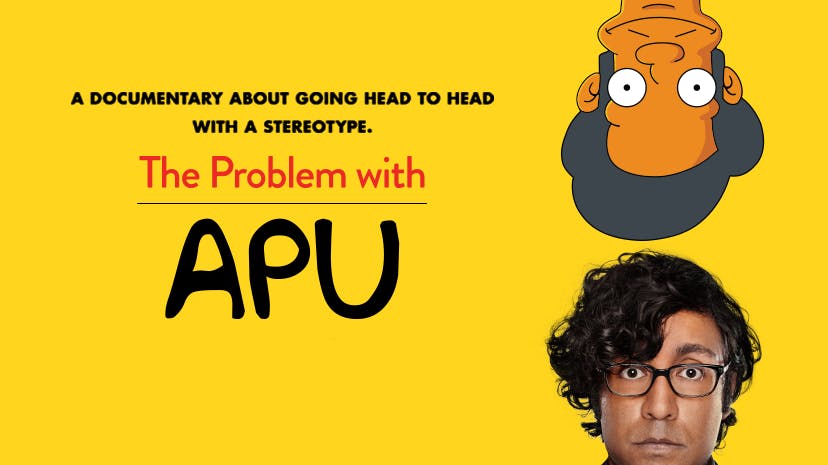
3rd and 4th generation Indian-American elites looking to climb this status hierarchy are acutely aware of the growth of the diaspora and its success— which means they no longer set the tone for the community. A good example is Hari Kondabolu, an unfunny man pretending to be a comedian. Kondabolu saw an opportunity to play the victim, cash in on his identity, and began a PR campaign to delete the character of Apu from the Simpsons. Despite pushback from other Indians, he was successful in destroying a beloved character for the sake of his personal benefit. Kondabolu’s story is illustrative of how assimilated Indians with no connection to their communities behave. They allow the elites to check the box of representation, helping to deflect any criticism from diaspora Indians by saying ‘ahh but your own community representatives disagree with you’. This has the additional benefit of discrediting genuine voices from the diaspora who take pride in representing our faiths and beliefs.
Additional demands are made of the diaspora community by left-wing Indians to genuflect at the altar of racial politics. In various op-eds by Indian-American writers from privileged backgrounds, one reads that Indians are insufficiently grateful to the civil rights struggles of earlier generations. Of course the only way to show our gratitude is for Indians to diminish their own voices and defer to others within the progressive hierarchy. Think about it, does any other ethnic group behave like this? Do the successful members of other minority groups lobby for unrelated related causes, while claiming to represent their community? Do they help their own communities to rise up, or do they pressure its members to refuse opportunities? Do they shut the doors of opportunity by enacting litmus tests?

Vishal Ganesan summarizes this dilemma:
The dutiful, hard-working immigrant who is grateful to their adopted country and a model for other immigrants is rejected as a normative ideal in favor of the committed ally who recognizes their privilege and dutifully subordinates the lessons of their own experience and culture to the demands of the coalition. Those who dissent from this model are increasingly condemned as some sort of traitors to the "culture" or, increasingly, "hindu supremacists."
The solution for Indian-Americans is to get politically organized. It’s time to start PACs, lobbies, and think tanks that represent our interests and values. We should embrace our heritage, while understanding the American context in which we live. Bridging the gap between these two worldviews is necessary for a more nuanced and respectful dialogue, not just within the Indian community, but with American society.
The Indian community’s strength lies in our ability to adapt and succeed in any environment, but we shouldn’t have to abandon our cultural values or be forced into simplistic binaries to do it. Indian-Americans must resist the temptation to let internal divisions weaken the community.
For American society, a united front is more effective in combating stereotypes and advocating for shared goals. The solution begins with a willingness to move beyond out-of-date ideas about a culture that has little resemblance to the Western framework— a culture that contains the largest population of English speakers in the world after America. Institutions, news media, and policymakers should strive to present a more nuanced understanding of Hinduism and Indian culture, moving away from the stereotypes that they’ve indulged in for decades without pushback— and there will be pushback. There are more Indians online now than ever and they will let you know how they feel.
American progressives should also examine their own double standards in how they approach immigrant communities. While advocating for multiculturalism and inclusion, they must avoid perpetuating narratives that dismiss the values and experiences of certain groups, such as Hindus, as incompatible with American ideals because they don’t agree with domestic or international politics. The lesson of the 2024 election is before them: alienating people by enforcing ideological conformity will continue to erode your coalition and open up avenues for alternative ideologies.

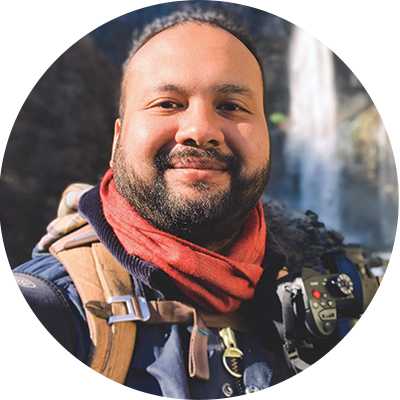
Member discussion